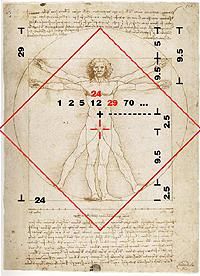Saturday, February 12, 2005

"The two squares, the drawn and the projection square, form an octagram Pell's series are the progressions that approximate the geometry of proportions originating from the octagram The first of Pell's series is:
1 2 5 12 29 70 169 ...
Both main numbers 24 (2x12) and 29 are members of this series. Leonardo used this progression to rationalise irrational geometry of square root of 2 that rules the geometry of the octagram. As a proof, all other numbers are derived as a combination of the members of the series. The distance between the two centers, the navel and Phallos, is according to rationalized geometry 2,5 palms, and it seems that the position of palms touching the square in Thau formation of the figure equals 9,5 palms, again the measure derived from rational approximation of the geometry of the octagram by means of Pell series. Also the diagonal of the square is calculated from the series as 2x(5+12) = 34 palms. The composition founded in octagram is one of the most spread cannons of proportions in ancient and classical architecture clearly presented by enormous opus of research done by Prof. Tine Kurent of Ljubljana School of Architecture, Slovenia. Almost every important christian church has dome placed on an octagram, and gematric value of Greek spelling for Jesus, Ihsous = 888 associates the number 8 (octagram) with Jesus Christ.
Most importantly even Vitruvius mentions the value of the octagon, though in a bit obfuscating manner, while describing the winds:
4. Some have held that there are four winds: the Solanus from the equinoctial east, the Auster from the south, Favonius from the equinoctial west, and Septentrio from the north. But those who have inquired more diligently lay down that there are eight: especially indeed Andronicus of Cyrrha, who also, for an example, built at Athens an octagonal marble tower, and, on the several sides of the octagon, had representations of the winds carved opposite their several currents.
Book I. c. VI: 4
Further on he describes that even the town-planning has to be done according to the octagonal scheme of the winds. It seems that Leonardo incorporated, in multiple layers, the whole cannon suggested by Vitruvius. It is a strange coincidence that the area of a square with a side of 24 palms is 576 square palms, which is gematric equivalent of Greek word for the wind meaning also Spirit, Pneuma = 576.
The calculated area of the circle is 660 square palms, and the difference between the circle and the square is 660-576=84, which is invoking the gematric value of the master himself:
LEONARDO = 12+5+15+14+1+18+4+15 = 84.
The 'fundamental' measure of 24 palms comes directly from Vitruvius' definition of human height being 4 cubits or 24 palms. Number 4 is of great importance in the composition of the drawing, emphasized with a square. Number 24 is important because it is 1x2x3x4 = 24, comprising the multiplied members of the Tetraktys. Vitruvius postulates the smallest module the division of 10 which also resembles the Tetraktys along with the previously mentioned diagonal of the square, 34 palms long: (1x2x3x4)+(1+2+3+4) = 34 - the Tetraktys numbers multiplied and added up. Half way between 24 and 34 is the diameter of the circle, 29 palms: (24+34)/2 = 29."
in
http://aiwaz.net
0 Comments:
